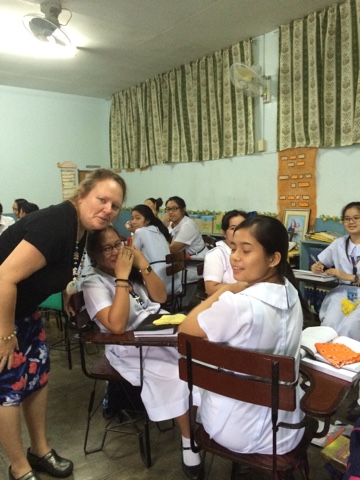Although we could not take our own pictures and had to leave our cell phones in the van, we did meet with Philip S. Goldberg, US. ambassador to the Philippines. He discussed the history of the Philippines and American education such as the Thomasites. I am paraphrasing, but he said, "America was not very good at colonizing because we focused on education. The Spanish and the English kept their colonies marginalized and powerless because of this lack of education. There is a great love for America in the culture, but we all know that American influence and power comes at a price for developing nations.
 |
| Printed posters with names and pictures are very big in the Philippines. We were welcomed at every school with a personalized banner. I wondered about how much all the printing might cost, but it did not seem to be an issue. |
This picture is of me in the culinary classroom of St. Paul College for girls in Manila. They have almost 4,000 students in this school. They suffered from the same problem of keeping teachers that all the private schools seem to suffer from. The public schools pay at least 25% more than private schools, so teachers are always leaving for more money.
The Philippines has small businesses everywhere. It doesn't appear that they must go through too much regulation to open restaurants, meat markets, vegetables etc. A "canteen" is mostly a place that sells food from large metal pots. I was super curious about these places, but we never ate at any of them because we were heavily warned that this would be gastronomically problematic.
This classroom is typical of a private school. In both public and private, students stay in one class and the teachers move from class to class. This teacher is discussing the Writing Process
Benigno "Ninoy" S. Aquino High School
We also toured a public high school in Makati. Classes were a bit larger, but this was also a high school that many students "chose" to come to instead of their neighborhood schools.






































